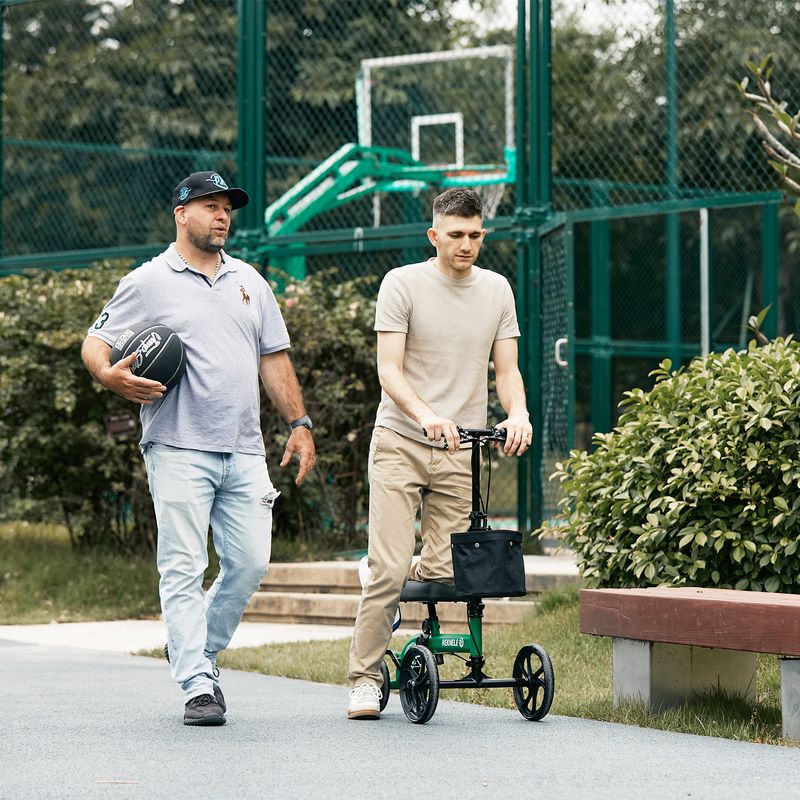
Introduction
Discover the innovative solution bestowed upon individuals afflicted with mobility challenges - the non-weight bearing upright walker. This remarkable contrivance seamlessly amalgamates the advantages of an upright walker with the expediency and solace of permitting users to retain their non-weight bearing status. Whether convalescing from an injury or grappling with a chronic ailment, this discourse uncovers the manifold ways in which the non-weight bearing upright walker bestows augmented mobility and independence.
Understanding the Non-Weight Bearing Upright Walker
1. What is a Non-Weight Bearing Upright Walker?
The non-weight bearing upright walker constitutes an ingenuous locomotive aid tailored to assist individuals with limited capacity for weight-bearing. It imparts support and steadiness while enabling users to sustain a non-weight bearing status in their injured or enfeebled limb. Resembling a conventional upright walker in structure, this device incorporates auxiliary features crafted to accommodate non-weight bearing individuals.
2. How Does it Work?
The non-weight bearing upright walker functions upon the principle of redistributing the user's weight away from the afflicted limb toward the opposing side of the corpus or the upper body. Distinguished by sturdy handles, adjustable height settings, and comfortable armrests, this apparatus facilitates manual maneuvering by permitting insertion of the non-weight bearing leg within its frame while relying on the hands and arms for support and locomotion. This ingenious contrivance grants individuals enhanced ease of movement and stability, assuaging the strain imposed upon the injured or weakened limb.
Choosing the Right Non-Weight Bearing Upright Walker
1. Consider Your Needs
During the selection of a non-weight bearing upright walker, judicious contemplation of one's specific needs and requisites holds paramount significance. Assay meticulously the extent of weight-bearing capacity and any other unique considerations germane to the individual's condition. This deliberate approach engenders a discernment of the features and specifications bespoke to the individual's circumstances.
2. Assess Comfort and Adjustability
Comfort and adjustability represent pivotal considerations in the acquisition of a non-weight bearing upright walker. It is germane to select a walker that proffers padded armrests, ergonomically designed hand grips, and adjustable height settings. These attributes assure customization to accord with comfort preferences and the perpetuation of proper posture while employing the walker.
3. Evaluate Durability and Maneuverability
The prospective acquisition ought to entail a walker characterized by durability and meticulous craftsmanship capable of withstanding regular employment. Scrutiny should revolve around robust materials and sound construction, affording adequate support and proffering lasting performance. Additionally, the maneuverability of the device should not be overlooked, with deliberation of turning radius and ease of navigation through sundry environments.
The Benefits of the Non-Weight Bearing Upright Walker
1. Enhanced Mobility
The non-weight bearing upright walker confers a substantial improvement in mobility for individuals ensnared by the difficulties of walking or supporting weight upon one leg. Through its provision of secure and stable support, it empowers users to navigate various terrains and move uninhibitedly. By instilling confidence, this device extends a reinstatement of mobility, facilitating the resumption of daily activities.
2. Improved Safety
Paramount importance attaches to safety in the realm of locomotive aids, and the non-weight bearing upright walker ardently fulfills this imperative. Its design and construction prioritize steadiness and equipoise, thereby attenuating the prospect of trips and mishaps. Endowed with this device, users may traverse their environment unencumbered by concerns of instability, engendering unimpeded focus on their movements.
3. Reduced Joint Impact
The non-weight bearing upright walker, by virtue of its non-weight bearing modality, efficaciously diminishes the impact sustained by joints, particularly those afflicted or enfeebled. Traditional walkers necessitate weight-bearing upon both legs, thereby potentially exacerbating joint discomfort and distress. The non-weight bearing upright walker affords users the capacity to safeguard their joints, ensconcing a convalescence marked by greater comfort.
4. Increased Independence
Independence constitutes an eminent component of overall well-being. The non-weight bearing upright walker bestows upon individuals the emancipation and self-sufficiency requisite to undertake daily tasks and engage in social activities. As an unfailing and efficient means of ambulation, this walker empowers individuals to nurture an active lifestyle, ensuring unfettered participation within their communities.

Conclusion
Embrace the liberty to ambulate and reclaim independence through the utilization of the non-weight bearing upright walker. Experience the manifold advantages of augmented mobility, enhanced safety, minimized joint impact, and heightened self-reliance. Engage in an earnest endeavor to select the non-weight bearing upright walker that impeccably harmonizes with individual necessities, thereby embarking upon a path characterized by enhanced mobility and self-empowerment.

